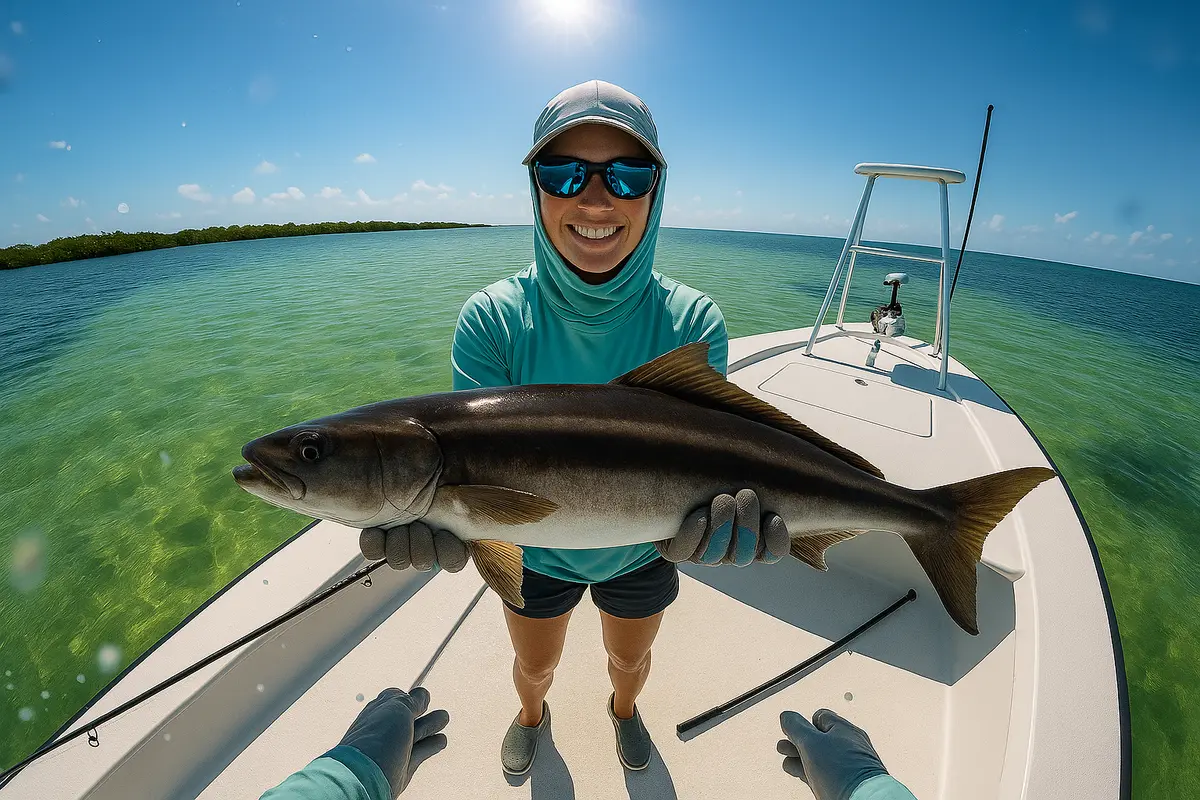Cobia: Habitats - Flats
Fishing the Flats for Cobia

Cobia will slide onto skinny water when temps, bait, and tide line up. On flats they behave like curious cruisers, often shadowing rays, turtles, and small sharks, or drifting along edges and potholes. Use this playbook to find them and make the shot.
Why cobia enter the flats
- Temperature lanes: Stable 68–78°F (20–26°C) brings cobia shallow to hunt and warm.
- Bait density: Mullet, pinfish, glass minnows, and small crabs.
- Rays & turtles: Cobia tailgate them to ambush flushed prey.
- Moving water: Tide across points, bars, and cuts creates short strike windows.
- Clear skies/low wind: Better sun angle = better sight-fishing.
When & where (regional cues)
| Region | Prime windows | Flats to check |
|---|---|---|
| Florida Keys | Late winter–spring; fall secondary | Oceanside flats near channels, ocean bars, turtle corridors |
| SW Florida (Charlotte–Estero) | Late winter–spring; fall bait run | Outside edge flats, passes, bar edges, deep potholes |
| Tampa Bay | Mar–Jun, then Sep–Nov | Flats adjacent to passes/Skyway, grass–sand transitions |
| Panhandle & N. Gulf | Apr–Jun | Clear sand flats, outer bars, ray trains on green-water days |
| Atlantic FL → Carolinas | Apr–Jun, late summer | Inlet bars and adjacent flats, turtle/ray drifts |
| Texas Coast | Late spring–summer | Laguna bars, sandy guts, big ray trains |
| Chesapeake & Mid-Atlantic | May–Aug (warm years) | Sandy shoals near channels, turtle corridors on flood tides |
Spotting fish
- Dark torpedo shapes gliding in 2–8 ft, often high in the water.
- Wingmen: Cobia parked off the hip of a cownose ray or turtle.
- Edges & potholes: Work sand/grass transitions and bar tips.
- Shadow reading: Look down-sun for contrast on breezy days.
- Lens choice: Copper/amber (green mirror) over grass; gray/silver over bright sand.
Boat handling & stealth
- Pole if you can; otherwise the quietest TM, bow to the wind/sun.
- Intercept, don’t chase: Lead the fish 45–60° and cross the beak.
- Kill sonar pingers in skinny water if fish act wary.
What to throw
| Category | Examples | How to fish |
|---|---|---|
| Jigs | 1–1.5 oz bucktails (white/chartreuse); “cobia jigs” with eel/grub | Land 2–3 m ahead; slow horizontal swim; speed up as they close |
| Swimbaits | 5–7" paddletails on ¾–1½ oz heads | Steady retrieve with 1–2 pauses; keep just above the nose |
| Soft jerk/Stick | 6–7" flukes on weighted hooks; big walkers (calm) | Throw past and swing across the face; twitch–twitch–go |
| Live | Small crabs, pinfish/pigfish, mullet/threadfin, eels | Free-line; keep moving naturally with the current |
| Fly | 5–7" baitfish/eel (tan/white, olive/white, black/purple) | 10-wt; long strips, then accelerate when they track |
Tackle for the job
- Spinning: 7'–7'6" MH–H, 6000–8000 size, 30–50 lb braid, leader 30–50 lb (go 60 lb only for big fish or rough edges).
- Conventional: 7' H with 30–40 lb mono/50 lb braid for heavier jigs/live baits.
- Fly: 9' 10-wt (11-wt in wind), large-arbor with stout drag.
- Tools: Dehooker, pliers, short net/cradle, quick-measure board.
- Always keep a “pitch” rod rigged with a crab or bucktail.
Presentation playbook
- Read direction & speed, plan a crossing shot.
- Lead farther than you think, then swim across the nose.
- Followers: Change speed first, then angle, then profile (switch to crab/white bucktail).
- Hook set: Circles—wind, don’t swing. Jigs/flies—firm sweep/strip.
- Boat-side: Keep them off the hull; short net/cradle; clear the deck.
Leaders on the flats (what most anglers actually use)
| Water/pressure | Artificial | Live bait | Fly (shock) |
|---|---|---|---|
| Clear, high pressure | 30–40 lb | 30–40 lb | 30–40 lb (some drop to 25–30) |
| Normal flats | 40–50 lb | 40–50 lb | 40–50 lb |
| Big fish / rough edges | 50–60 lb | 50–60 lb | 50–60 lb |
| Bridges/piers (not true flats) | 60–80+ lb | 60–100 lb | 50–60 lb |
Knots: FG (braid→leader), non-slip loop to jigs/flies, circle hooks for live baits.
Troubleshooting
- Follows, no eat: Lead more; speed up as they track; swap to crab or plain white bucktail.
- Spook on splash: Softer cast, lower entry angle, turn off sonar.
- Break-offs: Side-pressure them away from edges; bump leader one class and check for nicks.
- Hard to see: Run down-sun, copper lenses, elevate on a platform.
Quick packing list (flats)
Polarized glasses (copper/green mirror), hat/buff, two spinning rods or spin + fly, bucktails (1–1.5 oz), 5–7" paddletails, a few crabs/live baits, 30–60 lb fluoro, 6/0–8/0 circles, dehooker/pliers, short net/cradle, push pole or quiet TM.
Get the sun right, keep a pitch bait ready, and let the fish dictate the speed—flats cobia are the most fun “unexpected guest” you can plan for.
The World's Most Complete Fishing Resource
We're building the ultimate fishing encyclopedia—created by anglers, for anglers. Our articles are created by real experienced fishermen, sometimes using AI-powered research. This helps us try to cover every species, technique, and fishing spot imaginable. While we strive for accuracy, fishing conditions and regulations can change, and some details may become outdated or contain unintentional inaccuracies. AI can sometimes make mistakes with specific details like local access points, parking areas, species distributions, or record sizes.
Spot something off? Whether it's an incorrect boat ramp location, wrong species information, outdated regulations, or any other error, please use the "Help Us Improve This Page" section below. Your local knowledge makes this resource better for every angler.
Explore Related Topics
Discover more articles to deepen your knowledge
Curating articles for you...
Create your own Research Page using AI
Try our AI assistant for free—sign up to access this powerful feature